Review: Pottinger Terradisc 3001

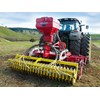

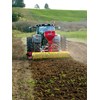
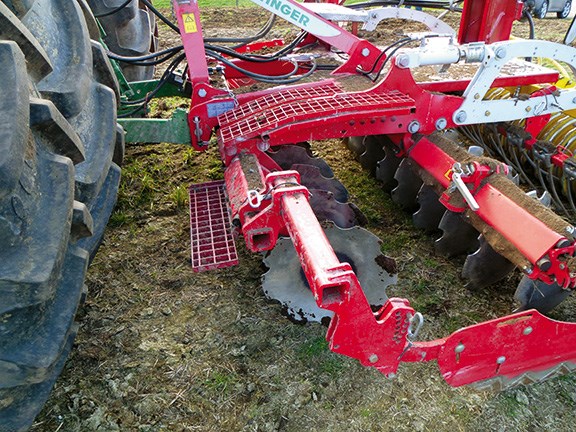 Top rows of 580mm diameter scalloped discs set at opposing angles aggressively cultivate the ground.
Top rows of 580mm diameter scalloped discs set at opposing angles aggressively cultivate the ground.

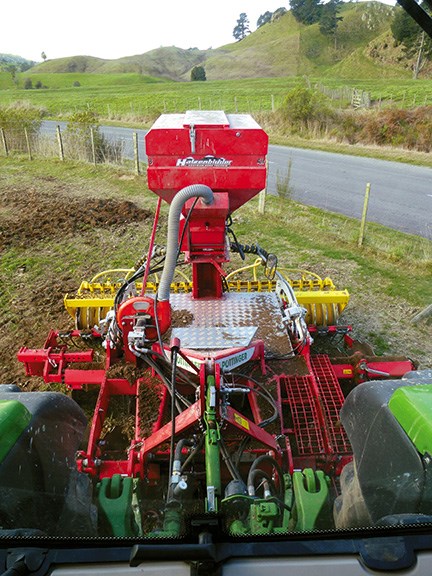 The open design of the main frame offers excellent visability from the cab.
The open design of the main frame offers excellent visability from the cab.

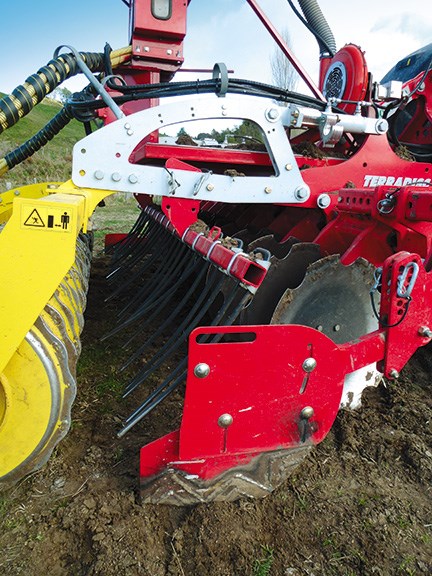 An adjustable row of finger tines behind the disc help level and break up the soil.
An adjustable row of finger tines behind the disc help level and break up the soil.

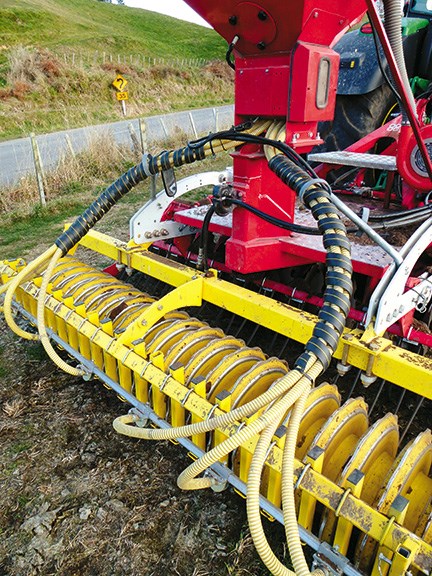 A heavy duty steel roller on the back uses deep packer rings to leave a firm seedbed.
A heavy duty steel roller on the back uses deep packer rings to leave a firm seedbed.

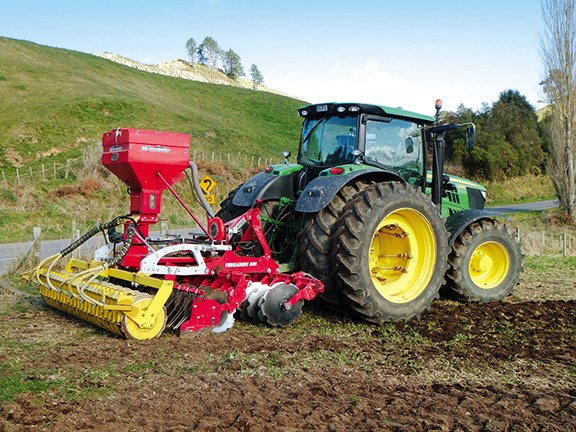

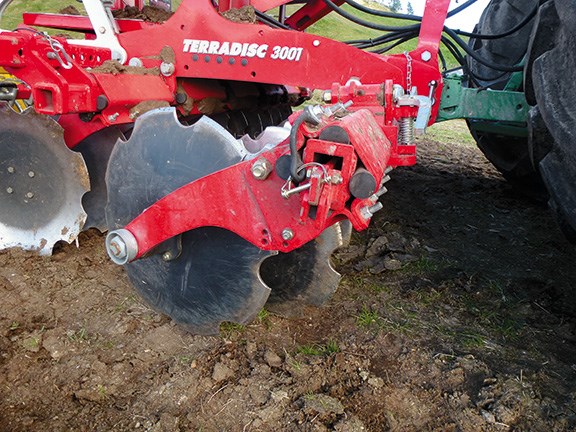 Discs on thin carrier arms are clamped to the main frame in pairs with rubber elements that allow movement and reduce shock on the frame.
Discs on thin carrier arms are clamped to the main frame in pairs with rubber elements that allow movement and reduce shock on the frame.


|

|

|
|
Top rows of 580mm diameter scalloped discs set at opposing angles aggressively cultivate the ground.
|

|
|
The open design of the main frame offers excellent visability from the cab.
|

|
|
An adjustable row of finger tines behind the disc help level and break up the soil.
|

|
|
A heavy duty steel roller on the back uses deep packer rings to leave a firm seedbed.
|

|

|
|
Discs on thin carrier arms are clamped to the main frame in pairs with rubber elements that allow movement and reduce shock on the frame.
|
Finding a machine tough enough to handle New Zealand's rugged conditions is no easy task, but the Pottinger Terradisc compact disc harrow seems to tick all the boxes.
Regardless of what you're planning on planting, when it comes to seedbed preparation I'm a firm believer in doing it right.
A well-cultivated firm seed bed gives crops the best possible start and eventually higher yields. For many the power harrow has become the go-to machine for secondary cultivation. That's because they generally do a good job in most situations, although they do have their pitfalls, such as high maintenance and running costs along with a relatively slow work rate.
Due to this, the European trend in more recent years has been a move away from the power harrow, to unpowered mounted and trailing tillage equipment, with higher forward speeds and outputs that still leave a seed bed in equally good shape.
The test
Recently I got to check out an operation here in New Zealand that has taken the plunge, largely ditching their power harrow in favour of one such machine; a Pottinger Terradisc 3001 for cultivation.
Stuart Deadman's Totara Park farm milks cows on around 1300ha north of Taupo in the central North Island. They run an extensive re-grassing programme which involves summer and winter cropping, as well as some conversion of forestry land in to pasture.
Since the Terradisc was purchased earlier this year it has covered around 50ha and so far has proven itself more than capable in the property's unique conditions. The light pumice soils found in this area aren't the toughest to work up, but they do have their unique challenges.
While Pottinger suggest that as little as 100hp is required to pull the three metre Terradisc, for this test I had a John Deere 6210R hitched on the front; possibly over-kill on the somewhat flat paddock we were in, but the operator suggested it was definitely required on some of the farm's steeper country.

The ground to be worked was winter crop that had been grazed off. While there was only a small amount of trash left on the surface, the ground was fairly compact after having cows on it. The plan was for one or two passes to be completed in order to create a seed bed for grass that was to be sown with a Hazenbichler air seeder mounted on the back of the machine.
Discs
The main frame is made of box section beams, while a sturdy headstock at the front couples the machine closely to the back of the tractor. CAT 2 pins are used with a variety of holes for different mounting positions.
Twenty-four scalloped discs of 580mm diameter are arranged at opposing angles in two rows. As each disc is bolted to the bearing housing with four bolts, eventual replacement should be simple while the maintenance-free, sealed twin race taper bearings also helps minimise downtime.
Bearings run on a stub axle which, in turn, is mounted to a slim profile cast iron carrier arm with plenty of clearance for soil to prevent blocking. Carrier arms are then mounted in pairs to the main frame with a wide clamp, which will prevent sideways movement of the discs.
The four rubber elements that are also cleverly squeezed into each clamp will take the shock away from the frame.
Operating at around 10-12km/h there's certainly potential to cover a lot of ground in a day. When looking down at the machine from the cab of the tractor, you can see just what a great job the discs do, lifting the soil and breaking it up.
Key to their success are deflector plates down each side which ensure that all the soil is contained within the width of the roller; this also guarantees a level surface. Set-up is really important. If the machine is trying to crab sideways or leave a ridge out one side, then it's probably not set up level, with one gang of discs cutting deeper than the other.
Although the working width of the machine is three meters, due to the offset nature of the discs and the deflector plates, the actual overall width of the machine is closer to 3.3 metres. To ensure you can take it on the road and get it through gateways, the outer sections on either side can be manually folded.
Tines
Following behind the discs are an optional row of large spring tines. These are well worthwhile in my opinion, although once again set-up is key. Adjustments can be made via pins, with a series of holes for different heights and angles.
The tines are set just deep enough to push a small amount of soil along in front, so they'll break up clods and level out any hollows without blocking up the machine.
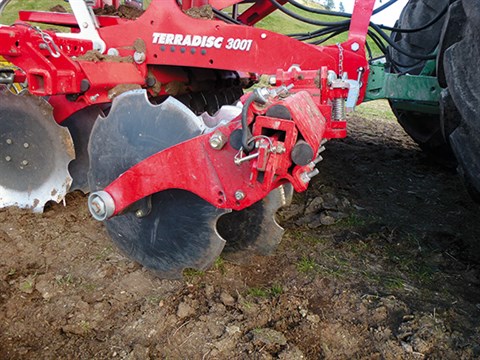
Roller
Cleverly the roller on the back of the machine is mounted in its own separate frame, which pivots off the main frame.
Two hydraulic rams are used to lift the roller up and down, controlling the working depth of the discs. Five millimetre thick shims on a hinge system alongside the ram spears are a simple yet effective way of fine tuning the depth. The fact they are on a hinge means they're always connected to the machine and there's little chance of them getting lost.
A problem I noticed with the Terradisc was due to its length when working on undulating ground; the discs will cut in too deep or come out of the ground as the machine rides over humps and through hollows.
As for the actual roller on the back, Pottinger offers a choice of five different roller combinations for the Terradisc – including a crumbler, packer ring and rubber roller – so there's something to suit all conditions.
The test machine was fitted with the most common packer ring roller. This uses deep steel packer rings which do an excellent job of further breaking up soil in order to leave a firm corrugated seed bed that will promote water absorption.
Verdict
The Pottinger Terradisc is an exceptionally well-built and thought-out machine. Thanks to its simplistic nature, maintenance and running costs will remain low.
There's little doubt in my mind the concept of this machine is well suited to many situation in New Zealand. On the pumice country found at Totara Valley, the Terradisc is an ideal machine to work the thin layer of topsoil without disturbing the underlying pumice.
Two passes solely with the Terradisc left an excellent seed bed. Although there are a wide variety of soil conditions across the country I imagine that in most situations a single pass after discing, ploughing or ripping would create a more than adequate seed bed.
For the latest farming news and reviews, subscribe to Farm Trader magazine here.
Keep up to date in the industry by signing up to Farm Trader's free newsletter or liking us on Facebook










.jpg)
.jpg)
.jpg)

